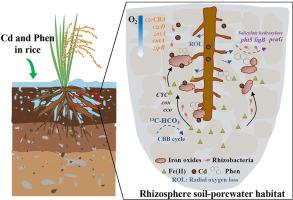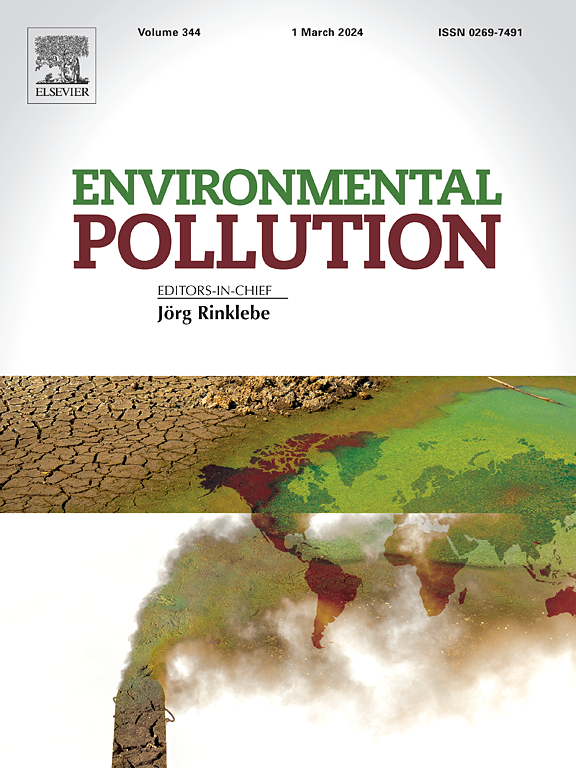DNA-stable isotope probing and metagenomics reveal Fe(II) oxidation by core microflora in microoxic rhizospheric habitats to mitigate the accumulation of cadmium and phenanthrene in rice
IF 7.6
2区 环境科学与生态学
Q1 ENVIRONMENTAL SCIENCES
引用次数: 0
Abstract
Rice rhizosphere soil-porewater microdomains exist within an iron (Fe)-rich microoxic habitat during paddy soil flooding. However, the response mechanisms of core microflora in this habitat to Fe(II)-oxidation-mediated cadmium (Cd) and phenanthrene (Phen) remain unclear. Using gel-stabilized gradient systems to replicate the microoxic conditions in the rice rhizosphere porewater, we found that microaerophilic rhizobacteria drove Fe(II) oxidation to yield iron oxides, thereby reducing the Cd and Phen contents in the rhizosphere porewater and rice (Cd and Phen decreased by 15.9%–78.0% and 10.1%–37.4%, respectively). However, co-exposure to Cd and Phen resulted in a greater reduction in the Cd uptake and a greater increase in the Phen uptake in rice as compared to those in the Cd or Phen treatments, possibly attributing to the cation-π interactions between Cd and Phen, as well as competition between the adsorption sites on the roots. The elevation of Cd-tolerant genes and Phen-degradation genes in biogenic cell-mineral aggregates unveiled the survival strategies of rhizobacteria with respect to Cd and Phen in the microoxic habitat. Potential Cd-tolerant rhizobacteria (e.g., Pandoraea and Comamonas) and Phen-degradation rhizobacteria (e.g., Pseudoxanthobacter) were identified through the DNA-SIP and 16S rRNA gene amplicon sequencing. Metagenomic analysis further confirmed that these core microbes harbor Cd-tolerant, Phen-degradation, and Fe(II) oxidation genes, supporting their metabolic potential for Cd and/or Phen in the microoxic habitat of the rice rhizosphere. These findings suggest the potential mechanism and ecological significance of core rhizospheric microbial-driven Fe(II) oxidation in mitigating the bioavailability of Cd and Phen in paddy soil during flooding.

DNA 稳定同位素探测和元基因组学揭示了微氧根瘤栖息地核心微生物区系对铁(II)的氧化作用,以减轻水稻中镉和菲的积累
水稻根圈土壤-孔隙水微域存在于水稻淹水期间富含铁(Fe)的微氧化生境中。然而,该生境中的核心微生物区系对铁(II)氧化介导的镉(Cd)和菲(Phen)的反应机制仍不清楚。利用凝胶稳定梯度系统复制水稻根瘤菌孔隙水中的微氧条件,我们发现嗜微气根瘤菌驱动铁(II)氧化产生铁氧化物,从而降低了根瘤菌孔隙水和水稻中的镉和菲含量(镉和菲含量分别降低了 15.9%-78.0% 和 10.1%-37.4%)。然而,与 Cd 或 Phen 处理相比,同时暴露于 Cd 和 Phen 的水稻对 Cd 的吸收量减少得更多,对 Phen 的吸收量增加得更多,这可能是由于 Cd 和 Phen 之间的阳离子-π相互作用以及根部吸附位点之间的竞争。生物细胞矿物聚集体中耐受镉基因和降解酚基因的增加揭示了根瘤菌在微氧生境中对镉和酚的生存策略。通过 DNA-SIP 和 16S rRNA 基因扩增片段测序,确定了潜在的耐镉根瘤菌(如 Pandoraea 和 Comamonas)和降解酚根瘤菌(如 Pseudoxanthobacter)。元基因组分析进一步证实,这些核心微生物携带耐镉、降解酚和铁(II)氧化基因,支持它们在水稻根瘤菌圈微氧生境中对镉和/或酚的代谢潜力。这些研究结果表明,根瘤菌圈核心微生物驱动的铁(II)氧化作用在洪水期间减轻水稻土壤中镉和酚的生物利用率方面具有潜在的机制和生态意义。
本文章由计算机程序翻译,如有差异,请以英文原文为准。
求助全文
约1分钟内获得全文
求助全文
来源期刊

Environmental Pollution
环境科学-环境科学
CiteScore
16.00
自引率
6.70%
发文量
2082
审稿时长
2.9 months
期刊介绍:
Environmental Pollution is an international peer-reviewed journal that publishes high-quality research papers and review articles covering all aspects of environmental pollution and its impacts on ecosystems and human health.
Subject areas include, but are not limited to:
• Sources and occurrences of pollutants that are clearly defined and measured in environmental compartments, food and food-related items, and human bodies;
• Interlinks between contaminant exposure and biological, ecological, and human health effects, including those of climate change;
• Contaminants of emerging concerns (including but not limited to antibiotic resistant microorganisms or genes, microplastics/nanoplastics, electronic wastes, light, and noise) and/or their biological, ecological, or human health effects;
• Laboratory and field studies on the remediation/mitigation of environmental pollution via new techniques and with clear links to biological, ecological, or human health effects;
• Modeling of pollution processes, patterns, or trends that is of clear environmental and/or human health interest;
• New techniques that measure and examine environmental occurrences, transport, behavior, and effects of pollutants within the environment or the laboratory, provided that they can be clearly used to address problems within regional or global environmental compartments.
 求助内容:
求助内容: 应助结果提醒方式:
应助结果提醒方式:


